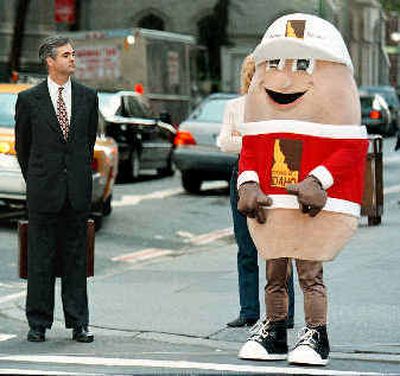Low-carb craze sidelines dancing spud

BOISE – Spuddy Buddy’s star role is over.
The rotund Idaho potato mascot isn’t dancing across the nation’s TVs to promote Idaho potatoes any more. Now it’s all about nutrition, fitness and the health benefits of eating potatoes despite the low-carb diet craze.
“Spuddy has his role,” said Frank Muir, president and CEO of the Idaho Potato Commission. “He’s still our mascot, but not our spokesperson.”
Instead, the Potato Commission has signed on fitness guru Denise Austin, a cheery, superfit fan of Idaho potatoes who has sold more than 20 million fitness videos and has her own exercise show on the Lifetime network.
“We’re talking about a food that has only 100 calories, no fat, no sodium, half your Vitamin C and twice the potassium as bananas,” Muir said. “You can eat potatoes and you can lose weight – just don’t put 10 pounds of butter on it.”
Here’s how Austin says it on the Potato Commission’s latest commercial: “A healthy diet is a matter of balance, so the idea of eliminating an entire major food group like carbohydrates just doesn’t hold up.”
Idaho’s marketing effort switched over to the nutrition angle a year ago, starting off with an ad focusing on the nutritional content of potatoes. But right around that same time, Gov. Dirk Kempthorne, who had starred in previous potato promotions along with Spuddy Buddy, revealed that he’d gone on the Atkins diet.
“I had heard good things about it, and I just wanted to stay in shape,” said the governor, who has lost 20 pounds. “Really, I’m about back down to my college weight. I think it’s important for longevity to be conscious of your weight and your exercise.”
But Kempthorne said he never entirely gave up eating potatoes. “I was raised on potatoes. I can’t give ‘em up,” he said. “I’d be happy to still do ads for the potato industry.”
Kempthorne said he’s still on a modified version of the Atkins diet, but eats potatoes regularly, including a basket of fries with burgers last weekend and some mashed potatoes with lunch on Monday. He particularly touts potato skins.
“They are nutritious. They’re not empty calories,” the governor said.
The potato industry worldwide has run into problems with the low-carb diet craze, and that’s meant trouble for Idaho’s No. 1 crop. Idaho produces a third of the nation’s potatoes, and about 1 percent of the potatoes sold worldwide.
From 2002 to 2003, according to the U.S. Potato Board, revenue from fresh potato sales in U.S. grocery stores was down 12.5 percent, though the volume sold was up 2.6 percent. That was when the diet craze was hitting, and was a big change from the previous year, which saw revenue up 24 percent and volume flat.
So far this year, revenue is down another 12.8 percent.
“It’s not a disaster, but we have a lot of things we need to do to help educate the consumer about the nutritional benefits of the potato,” said Mac Johnson, vice president of the national board. “The potato’s not all carbs or all fat, it is in fact a good, solid part of a nutritional diet.”
The sales drop, which included heavy discounting of 10-pound bags of potatoes to move the volume out, isn’t all due to the diet craze, Johnson said. For several years, trends – including less time to cook at home and changing families – have contributed to declines in the use of fresh, home-cooked potatoes.
“All those things have certainly contributed, but they’re not the single answer to what we as an industry have got to do to get the sales turned around,” he said.
Johnson said he thinks the industry “has a significant opportunity to maintain our place as America’s favorite vegetable.” Muir is optimistic that the low-carb craze has peaked, and potatoes are making a comeback as a health food suitable for dieters and others. In fact, he’s done more than 400 media interviews in the past year to counter the low-carb message, and that’s given the humble spud lots of publicity.
“I think I would say the fever of the Atkins diet actually helped us,” Muir said. “Controversy breeds notoriety.”
Idaho’s fresh potato sales, which were down slightly last year, are holding even this year, Muir said. “We’re basically about dead even in terms of total dollars versus a year ago,” he said. “I think whatever downward trend was there, and possibly due to the Atkins diet, is being mitigated by a lot of the things we’re doing. We have an absolutely gorgeous crop this year. Growing conditions were ideal.”
Last year’s Idaho potatoes, impacted by an extended hot spell, were smaller than normal, Muir said, but this year’s are back up to standards for the famous spuds.
Muir said the commission wants to press the message that potatoes are healthy – even if some of the ways people have traditionally prepared them aren’t, such as loading up a baked potato with butter and sour cream. “Salsa, broccoli,” he said. “There are lots of ways to eat a baked potato. It’s not that potatoes were ever bad for us – it’s just we do bad things to it.”
Rather than deep-fry potatoes for fries, for example, he said people can cut potatoes into strips, lightly coat them with olive oil and bake them, yielding tasty, lower-fat fries.
Said Muir, “When people say, ‘I like them, but I can’t eat them because they make me fat,’ we’ve got to go head-on and say, ‘That isn’t true.’ “